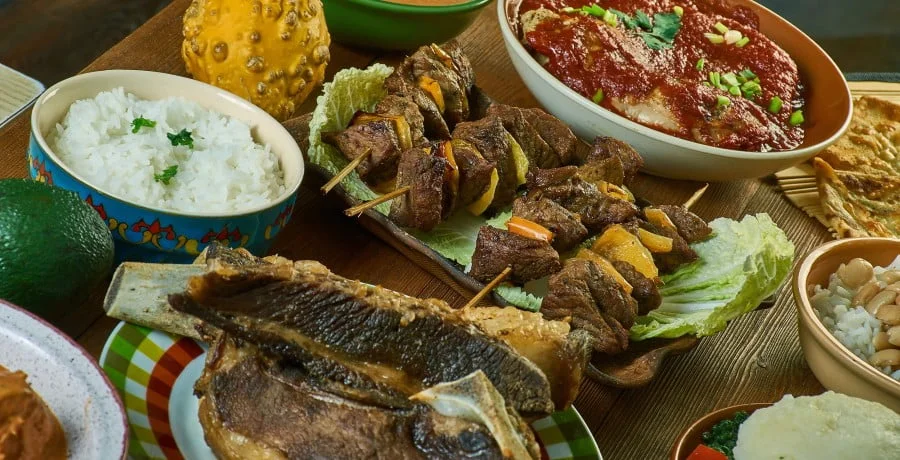Take Me to The Recipes
Tanzania, nestled on the eastern coast of Africa, is blessed with a rich tapestry of landscapes. Tanzanian Cuisine is influenced by the country’s geography and climate. This spreads from the lofty peaks of Mount Kilimanjaro to the deep blue waters of the Indian Ocean. Its equatorial climate is characterized by warm temperatures year-round, interspersed with two rainy seasons.
This East African country boasts a myriad of natural wonders like the Serengeti National Park and the Ngorongoro Crater. Dominated by agriculture, Tanzania is a major producer of coffee, tea, and tobacco. With a population of over 60 million, the country’s culinary traditions are deeply interwoven with its rich history and diverse ethnic groups.
Tanzanian cuisine is a harmonious blend of native African, Indian, and Arabian influences. From the bustling streets of Dar es Salaam to the serene beaches of Zanzibar, Tanzanian dishes echo tales of trade, migration, and local traditions. Join us as we explore this fascinating country’s culinary heritage.
Tanzanian Cuisine – Key Takeaways
- Tanzanian cuisine is a blend of native African ingredients with Indian, Arab, and European influences.
- Staple foods include maize, rice, and coconut.
- Street foods, like Zanzibar pizza and mishkaki, are popular.
- Many dishes are seasoned with a mix of spices, reflecting the country’s trade history.
- Most meals are traditionally served with a type of porridge called “ugali.”
- Fruits like mangoes, pineapples, and bananas often feature in desserts.
Where is Tanzania?

The United Republic of Tanzania is an East African country bordering the Indian Ocean. Its Neighbors are Kenya and Uganda, to the north, Rwanda, Burundi and Democratic Republic of the Congo, to the west, and Zambia, Malawi and Mozambique to the south. The country includes the island of Zanzibar.

Index to Contents
- Take Me to The Recipes
- More Articles
- 10 Interesting Facts about Tanzania
- The History of Tanzania and the Impact it has had on the Food
- How Tanzania’s Climate and Geography has Influenced Tanzanian Cuisine
- Tanzanian Culinary Traditions
- How Healthy is Tanzanian Food?
- The Most Popular Tanzanian Food
- Understanding the Essence of Tanzanian Cuisine
- Tanzanian Food – Great Tanzanian Recipes to try at Home
- Tanzanian Food
- There is a Huge Variety of Tanzanian Food
- Conclusion
- FAQ’s
You may also be interested in the Following Articles
- North and South American Cuisine – A Culinary Expedition
- European Cuisine: Savor the Continent’s Best Culinary Secrets!
- African Cuisine: Discover the Bold Flavors & Global Charm!
- Asian Cuisine Unlock its Secrets – Taste, Health & Global Influence!
- Oceania Cooking: A Culinary Journey Through the Pacific
Savor iconic Tanzanian Food Recipes – Click on each tantalizing picture to open up the Recipe
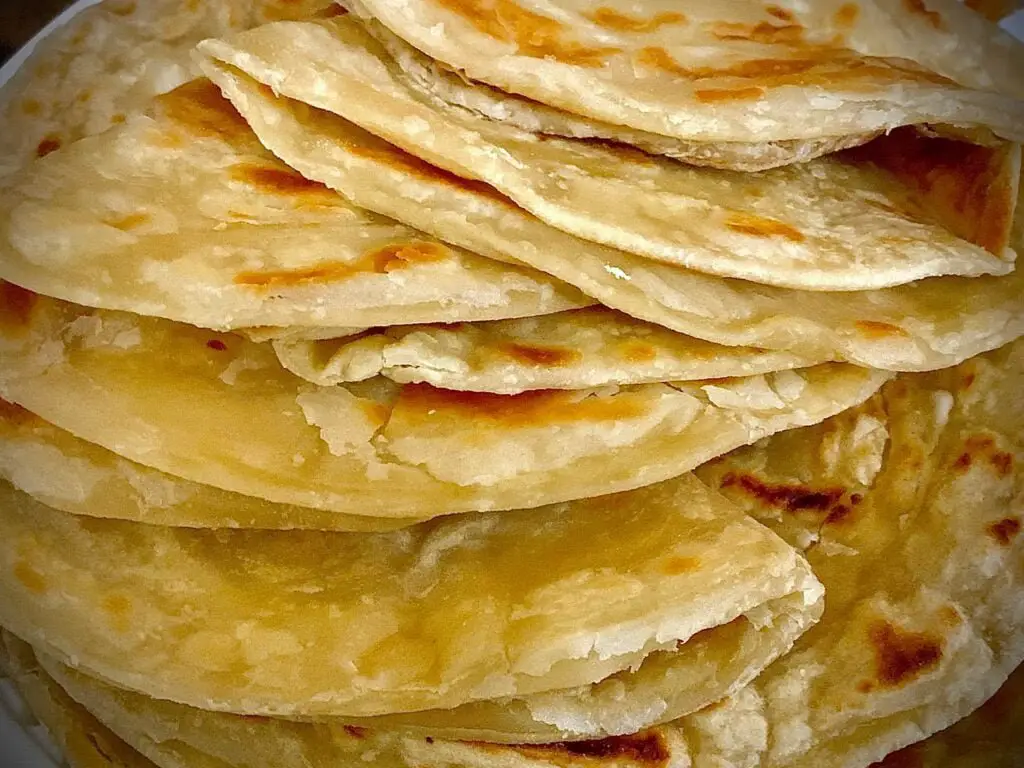

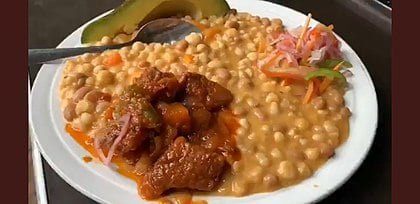



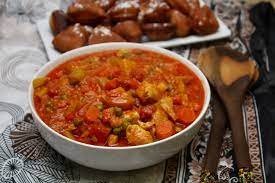
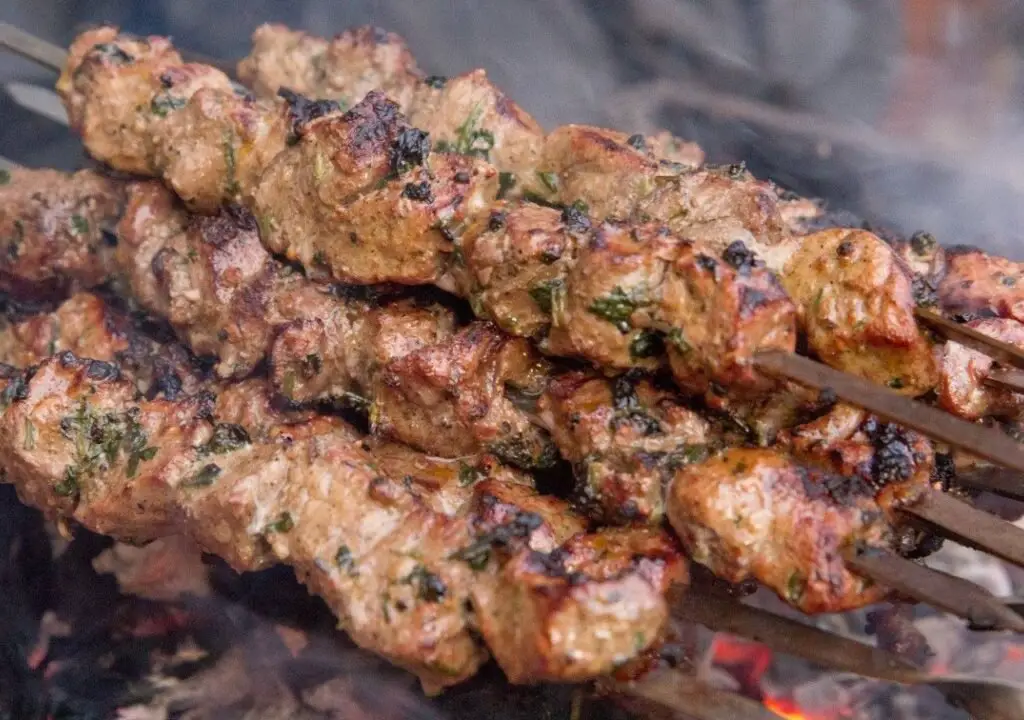

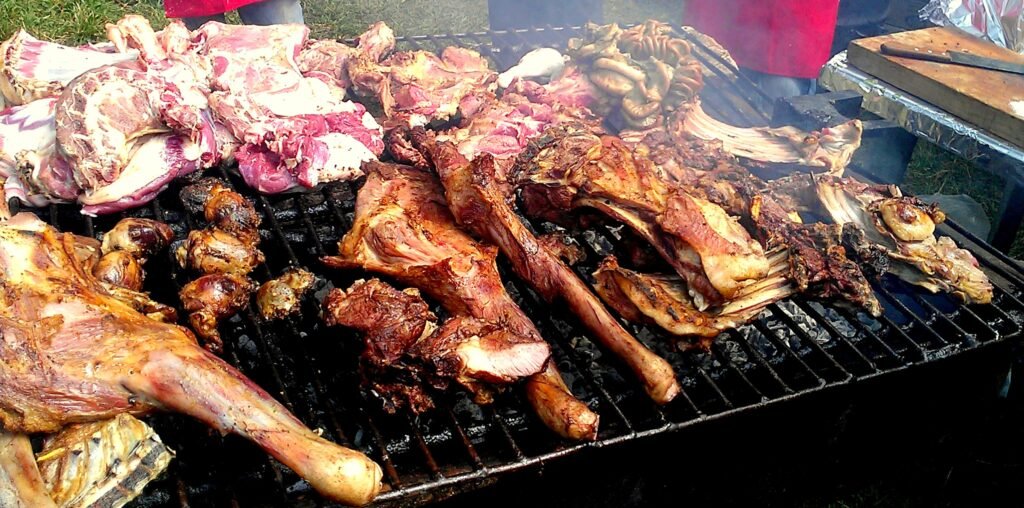



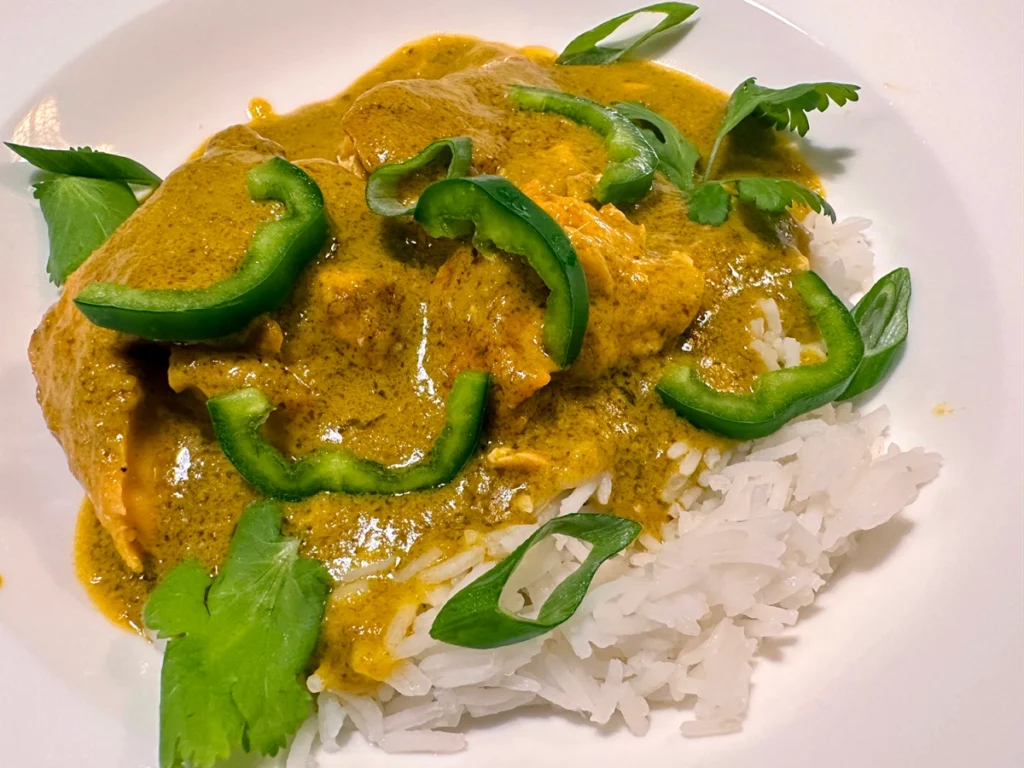
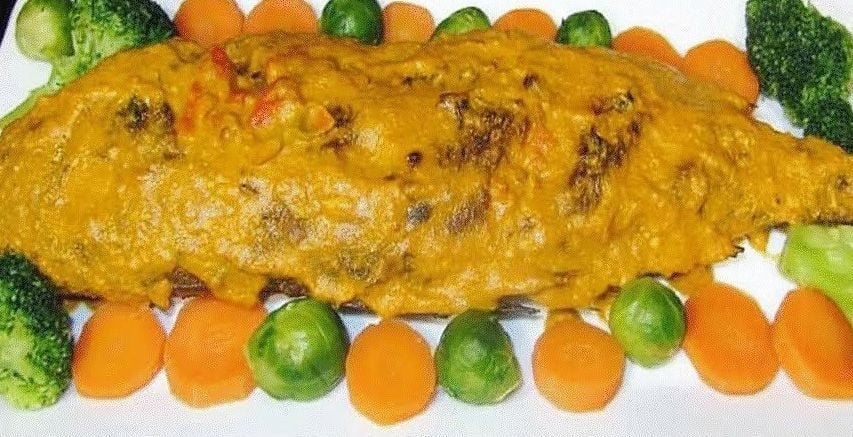


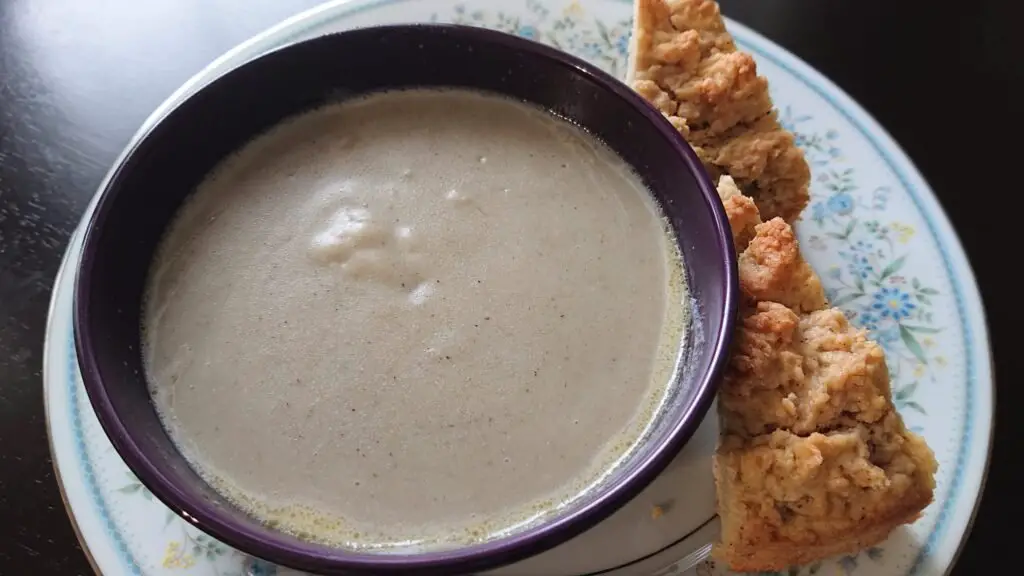
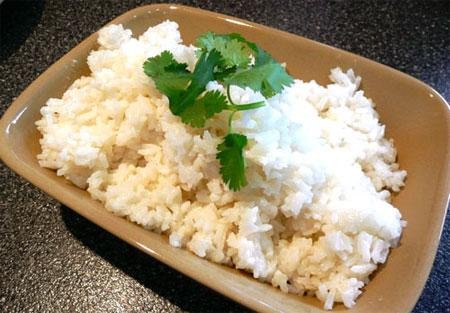
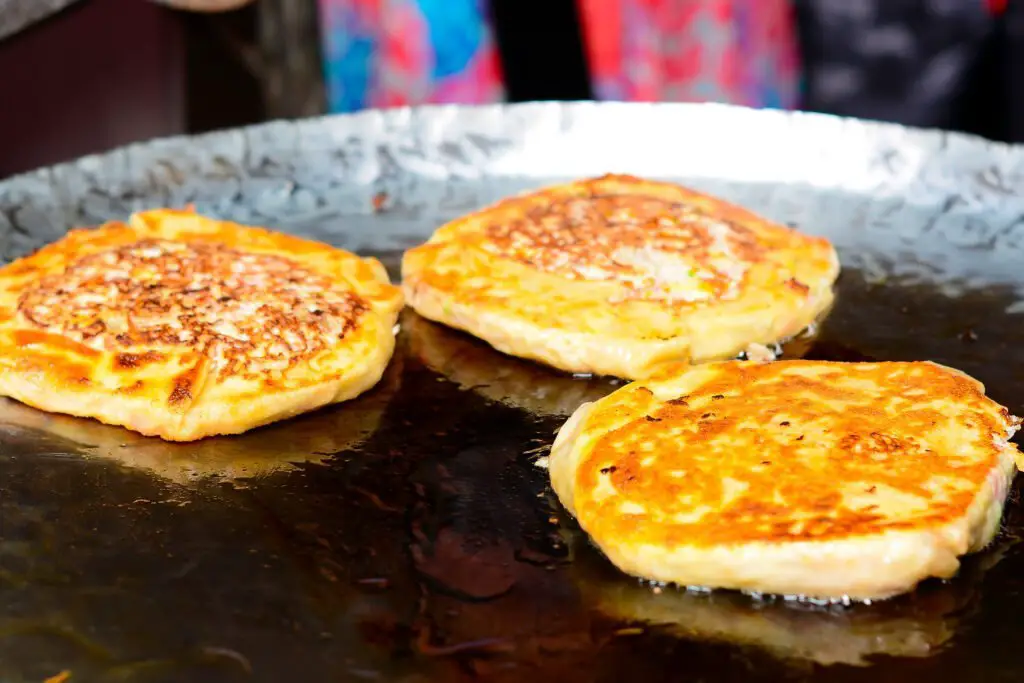


10 Interesting Facts about Tanzania
1. Tanzania’s Towering Treasure: Mount Kilimanjaro

If you ever lay eyes on it, Mount Kilimanjaro will surely make your jaw drop! This snow-covered, cone-shaped giant is not just the tallest mountain in Africa but also the highest freestanding peak globally, standing tall at 5,895 meters above sea level.
You can spot almost every type of ecosystem there – from cultivated land to rainforests, alpine deserts, and even arctic peaks. Feel free to admire this dormant volcano from the ground, or if you’re feeling adventurous, strap on your climbing boots for breathtaking views!
2. The Great Wildebeest Migration: A Million-Animal Adventure

Over 1.5 million wildebeest, zebras, and gazelles embark on a journey across the plains of Tanzania and Kenya during the Great Wildebeest Migration.
Picture this: river crossings at Mara River, where these animals dodge crocodiles and other dangers. It’s like the wildebeest Olympics, and the river crossing steals the show!
3. Tanzania’s National Park Extravaganza
Guess what? Nearly 30% of Tanzania is covered in national parks! The Serengeti National Park, a World Heritage Site and the 7th World Wonder, hosts a million large mammal species. Elephants, giraffes, leopards, and even the endangered Eastern black rhinoceros call it home.
Don’t forget the Selous Game Reserve, boasting the largest elephant population, and Gombe Stream National Park, where Dr. Jane Goodall did her famous chimpanzee research.
4. Lake Tanganyika: Big Lake, Bigger Biodiversity

Lake Tanganyika, the second-largest lake globally, is a freshwater paradise shared by Tanzania, Burundi, Zambia, and the Democratic Republic of the Congo.
With 500 fish species, it holds 8% of the world’s freshwater. Most fish keep it chill near the surface, staying within 20 meters.
5. Tanzania’s Purr-fectly Unique Lions

Head to Tarangire National Park for a unique sight – tree-climbing lions! Why they’ve taken up this hobby is a mystery. Some say it’s for a cool breeze, others think it’s a strategic move against tsetse flies.
Maybe, just maybe, they’re tree enthusiasts enjoying the view from above!
6. Ngorongoro Crater: The Big Five Hotspot
Ngorongoro Crater, a volcanic masterpiece in northern Tanzania, is a wildlife safari wonderland and one of Africa’s Seven Natural Wonders. Its compact size creates a unique ecosystem, offering primo chances to spot the Big Five
- lions
- buffalos
- leopards
- elephants
- rhinoceroses.
7. Olduvai Gorge: A Peek into Ancient History
Olduvai Gorge, surrounded by a picturesque lake, holds a remarkable secret – ancient human fossils dating back millions of years. These bones, including the oldest human skull, tell the story of our earliest ancestors.
8. Zanzibar’s Historical Struggle
Zanzibar, known for its spice trade, also has a darker history. It was a hub for Arab and Indian slave traders, with the final active slave market in Stone Town.
Around 40–50,000 slaves were brought here annually until the British put their foot down in 1873.
9. Tanzania’s Stunning Waterfalls

Amidst lakes and mountains, Tanzania boasts breathtaking waterfalls. Kalambo Falls, near Zambia, plunges 772 feet in one go, making it one of Africa’s highest falls. Materuni Waterfalls, near Kilimanjaro, offers a serene escape from daily chaos.
10. The Blink-and-You-Miss-It War
Tanzania holds a record for the shortest war in history – the Anglo-Zanzibar War of 1896 lasted a mere 38 to 45 minutes!
Why? The British didn’t fancy the Sultan’s chosen successor, so they let loose with 4,100 machine gun rounds, 1,000 rifle rounds, and 500 shells. Talk about efficiency!
Bonus Tidbits
- Baobab trees in Tarangire National Park can live for 1,000 years!
- Tanzania, once ruled by Germany, joined the British Empire in 1961.
- With over 100 languages, Tanzania takes the crown for linguistic diversity.
- It hosts Africa’s highest (Mount Kilimanjaro) and lowest (Lake Tanganyika) points.
- Freddie Mercury, the Queen frontman, was born in Zanzibar.
- Tanzania’s 100+ tribes coexist peacefully, respecting cultural and religious diversity.
The History of Tanzania and the Impact it has had on the Food
Tanzania’s history and cuisine are influenced by its diverse geography, culture, and trade. Here are some of the main historical periods and their effects on Tanzanian food:
Pre-Colonial Tanzania

Tanzania, with its diverse ethnic groups and rich cultural tapestry, has a deep history that predates colonial influences. The indigenous communities in Tanzania, such as the Maasai, Chaga, and Sukuma, developed unique culinary traditions.
Traditional Tanzanian cuisine during this period primarily relied on locally sourced ingredients, including grains, vegetables, fruits, and various meats. The availability of abundant natural resources and fertile land shaped a diet that was based on agriculture, livestock, and hunting.
Colonial Era Impact on Tanzanian Food

During the late 19th century and early 20th century, Tanzania fell under German and later British colonial rule. This period witnessed significant changes in the culinary landscape. European settlers introduced new crops such as coffee, tea, and various spices, altering the agricultural practices of the region.
The integration of these new ingredients into Tanzanian cuisine influenced both everyday meals and festive dishes. Additionally, the introduction of European cooking techniques left a lasting impact on the preparation and presentation of Tanzanian food.
Post-Independence and Modern Times

Tanzania gained independence in 1961, and subsequent decades saw efforts to reclaim and celebrate indigenous cultures. This movement extended to the culinary domain, where traditional dishes regained prominence.
Tanzanian cuisine today is a delightful blend of indigenous flavors and influences from diverse communities. Staples like ugali (maize porridge), nyama choma (grilled meat), and various stews showcase the resilience of traditional foods.
Globalization and Contemporary Influences
In recent years, globalization has further shaped Tanzanian cuisine. The influx of international food trends, coupled with increased trade, has introduced a variety of ingredients and cooking styles.
Urbanization and lifestyle changes have also impacted dietary habits, with convenience foods becoming more prevalent.
Conclusion
Tanzania’s history, marked by periods of indigenous traditions, colonial influences, and modern dynamics, has significantly shaped its culinary landscape. The fusion of traditional and introduced ingredients, cooking methods, and cultural exchanges has resulted in a diverse and vibrant Tanzanian cuisine.
The resilience of traditional dishes and the adaptation to new culinary influences reflect the country’s dynamic history and cultural identity.
References
How Tanzania’s Climate and Geography has Influenced Tanzanian Cuisine
Tanzanian cuisine is influenced by its diverse geography, climate, and culture. Here are some of the ways how:
The Coastal Region

This region has a hot and humid tropical climate, which allows the cultivation of fruits, vegetables, spices, and rice. The coast also has access to seafood, such as fish, crabs, and oysters.
The coastal cuisine is influenced by the Arab, Indian, and Persian traders who brought new ingredients and dishes, such as pilau, biryani, curry, samosas, and chapati. Coconut milk, cardamom, cloves, cinnamon, and saffron are also common in the coastal dishes.
The Central Plateau
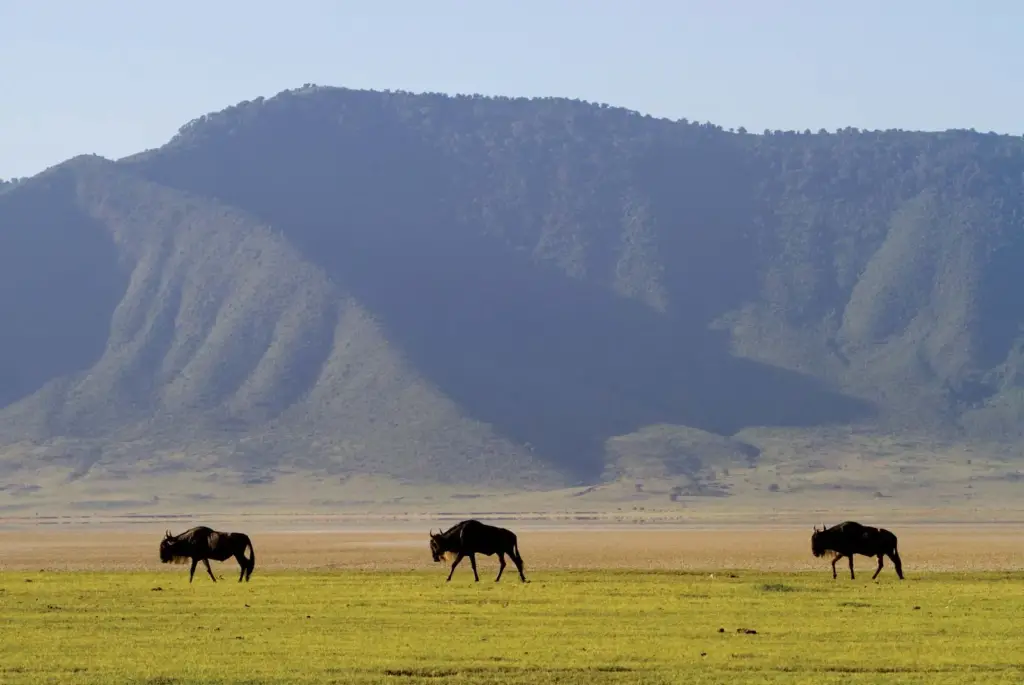
This area has a dry and arid climate, which limits the availability of water and crops. The staple food in this region is ugali, a thick porridge made from maize flour. Ugali is usually eaten with meat, beans, or vegetables, such as spinach, okra, or pumpkin leaves.
The central cuisine is also influenced by the pastoralist communities, such as the Maasai, who consume milk, meat, and blood from their cattle.
Tanzanian highlands
The highlands have a cooler and wetter climate, which favors the production of coffee, tea, bananas, and potatoes. The highland cuisine is influenced by the European colonizers, who introduced new crops and cooking methods, such as baking and frying.
Some of the dishes in this region are mandazi, a fried doughnut; ndizi nyama, a stew of bananas and meat; and chipsi mayai, a dish of fries and eggs.
Tanzanian lake regions
The lake regions have a humid subtropical climate, which supports the cultivation of cassava, millet, sorghum, and yams. The lakes also provide fish, such as tilapia, catfish, and dagaa.
The lake cuisine is influenced by the Bantu, Cushitic, and Nilotic ethnic groups, who have their own languages, customs, and cuisines. Some of the dishes in this region are mtori, a soup of bananas and meat; mchicha, a dish of spinach and peanut sauce; and makande, a dish of beans and maize.
I hope this answers your question. If you want to learn more, you can check out some of the web search results I found for you:
References
Understanding the Essence of Tanzanian Cuisine
Tanzanian cuisine is a mosaic of flavors, borne from its diverse ethnic groups, historical trade routes, and the bounteous produce of its varied landscapes. Infused with the traditions of over 120 ethnic tribes and influenced by Indian, Arab, and European settlers, the essence of Tanzanian cuisine is a harmonious blend of cultures.
The coastal regions, enriched by the Indian Ocean’s bounty, offer dishes with coconut, fish, and spices. Coconut bean soup, samosas, and the flavorful pilau, a spiced rice dish, mirror the Swahili coast’s historical trade ties with Middle Eastern and Indian merchants.
In contrast, the inland regions highlight staples like maize, millet, and sorghum. Ugali, a dense, dough-like dish made from maize flour, is a national favorite, often paired with nyama choma (grilled meat) or a rich vegetable stew.
Tanzania’s love for street food stands evident in dishes like mishkaki (skewered meat) and chipsi mayai (an omelette mixed with fries). Meanwhile, the morning streets are fragrant with the aroma of maandazi, sweet deep-fried dough balls, and chai spiced with cardamom and ginger.
However, the essence of Tanzanian cuisine isn’t solely in its flavors. It’s in the communal manner of dining, where sharing is central. Meals become moments of togetherness, be it families gathered around large platters of biryani during festive times or friends sharing stories over mugs of sugarcane juice.
Indeed, Tanzanian cuisine is a testament to the country’s rich tapestry of influences, blending indigenous techniques with foreign flavors. But at its core, it remains a cuisine that celebrates community, connection, and the diverse bounty of its land.
Tanzanian Food
Tanzania, a diverse country in East Africa, boasts a rich tapestry of cultures, landscapes, and flavors. The fusion of indigenous, Arabic, and Indian influences have yielded an exquisite culinary heritage.
At the heart of Tanzanian cuisine lies “ugali,” a dense, maize-based staple that’s versatile and complements many dishes.
Often paired with “nyama choma” (grilled meat) or “mchuzi” (stew), it forms the foundation of many a Tanzanian meal.

The coastal regions, influenced by centuries of trade, offer a bounty of seafood delicacies. Dishes like “samaki wa kupaka” (coconut fish curry) showcase the use of coconut and aromatic spices reminiscent of Zanzibar’s spice trade history. Moreover, “wali wa nazi” (coconut rice) is a beloved accompaniment.
Street food culture thrives in Tanzanian towns. “Mishkaki” (skewered meat), akin to kebabs, tantalizes with its smoky aroma, while “chapati” (flaky flatbread) and “mandazi” (doughnut-like confections) are perfect for a quick snack.
A refreshing sip of “uji” (millet porridge) or “chai” (tea) with spices and milk rounds off the experience.
In Tanzania, a meal isn’t just about nourishment; it’s a communal event, a time to bond and share stories. The tradition of eating from a shared plate or pot signifies unity and brotherhood. From the grassy plains of the Serengeti to the bustling streets of Dar es Salaam,
Tanzanian culinary traditions are a testament to the country’s rich history, making every bite of Tanzanian Food a journey through time and culture.
There is a Huge Variety of Tanzanian Food
Tanzanian food is known for its rich variety and bold flavors. The cuisine reflects the country’s diverse cultural influences, with influences from Arab, Indian, and African culinary traditions. ‘
A typical Tanzanian meal often features a combination of staple foods such as ugali, a cornmeal porridge, served with various meats, fish, or vegetables. Traditional dishes like pilau, a fragrant rice dish cooked with spices, and nyama choma, grilled meat, are popular choices among locals and tourists alike.
Tanzanian food offers a delightful exploration of the country’s vibrant culinary heritage.
Tanzanian Culinary Traditions
Tanzanian culinary traditions are a reflection of the country’s diverse history, culture, and geography. Tanzanian cuisine is influenced by the Swahili, Arab, Indian, and European cuisines, as well as the local ethnic groups and resources. Some of the common features of Tanzanian cuisine are:
Staple Foods
The use of staple foods, such as maize, cassava, rice, and plantains, which are often cooked into porridge, bread, or pancakes. These staples are usually accompanied by various sauces, stews, or curries, made with meat, fish, beans, or vegetables.
Spices

The use of spices, such as curry, cardamom, cloves, cinnamon, and saffron, which add flavor and aroma to the dishes. These spices were introduced by the Arab and Indian traders who visited the Tanzanian coast.
Coconut milk is also a common ingredient in the coastal cuisine, giving it a creamy and rich texture.
Grilled or Barbecued Meat
The use of grilled or barbecued meat, such as beef, goat, chicken, or fish, which are marinated and seasoned with salt, pepper, and paprika. These meats are often skewered and cooked over charcoal, creating a smoky and tender result.
They are usually served with fries, bread, or salad.
Fermented Foods
The use of fermented foods, such as yogurt, cheese, and pickles, which have probiotic benefits for the health and digestion. Yogurt is especially popular in Tanzania, as it is made with a unique bacteria called Lactobacillus bulgaricus, which is native to the country.
Yogurt is often eaten with bread, porridge, or fruit, or used as a base for soups and sauces.
How Healthy is Tanzanian Food?

The health of the Tanzanian population and the Tanzanian cuisine are influenced by various factors, such as the availability of resources, the quality of health services, the prevalence of diseases, the dietary habits, and the cultural practices. According to some of the web search results I found, here are some of the main points:
The Tanzanian population faces many health challenges, such as high rates of maternal and child mortality, infectious diseases, malnutrition, and non-communicable diseases.
The country has made some progress in improving health outcomes, such as reducing under-five mortality, increasing immunization coverage, and expanding access to HIV/AIDS treatment.
However, there are still significant gaps in health equity, quality, and financing.
The Food
The Tanzanian cuisine is generally considered healthy, as it is based on fresh and natural ingredients, such as fruits, vegetables, dairy products, meat, and herbs.
Tanzanian cuisine also incorporates various fermented foods, such as yogurt, cheese, and pickles, which have probiotic benefits for the gut health and immune system.
However, like any cuisine, Tanzanian cuisine can also have some drawbacks, such as high salt, fat, and sugar content in some dishes, such as cured meats, pastries, and desserts.
Some traditional dishes may also be high in calories and carbohydrates, such as ugali, pilau, and banitsa. Therefore, moderation and balance are important for enjoying Tanzanian cuisine in a healthy way.
References
The Most Popular Tanzanian Food
Tanzanian food is a blend of different cuisines and influences, such as Swahili, Arab, Indian, and European. Some of the most popular Tanzanian dishes are:
- Ugali: A thick porridge made from maize flour, which is eaten with meat, beans, or vegetables. It is the staple food in many regions of Tanzania.
- Mandazi: A fried bread that is similar to a doughnut, but not as sweet. It can be eaten as a snack or with tea. It is a common street food and breakfast item.
- Vitumbua: A deep-fried rice cake that has a coconut flavor. It is usually served with tea or coffee. It is a popular breakfast dish in the coastal areas.
- Pilau: A rice dish that is cooked with spices, such as cardamom, cloves, cinnamon, and saffron. It can also have meat, fish, or vegetables. It is influenced by the Indian and Persian cuisines.
- Chapati: A flatbread that is made from wheat flour and water. It can be eaten with stews, curries, or salads. It is also influenced by the Indian cuisine.
- Mchuzi wa samaki: A fish curry that is cooked with coconut milk, tomatoes, onions, and spices. It is a typical dish of the coastal cuisine. It can be eaten with rice, ugali, or chapati.
- Mishkaki: A skewered meat that is marinated and grilled over charcoal. It can be made from beef, goat, chicken, or fish. It is often served with fries, bread, or salad. It is similar to a kebab.
- Chipsi mayai: A dish of fries and eggs that are cooked together in a pan. It can also have cheese, onions, or peppers. It is a cheap and filling snack or meal.
Tanzanian Food – Great Tanzanian Recipes to try at Home
The culinary charm of Tanzanian cuisine lies in its simplicity and flavor. Rooted in the bounties of nature, traditional Tanzanian dishes predominantly use locally sourced ingredients, with rice, maize, and coconut forming the base.
The nation’s coastal position and historic trade relations mean that spices are liberally used, infusing dishes with unique aromas and flavors.
Tanzanian Food – Maandazi ya Karanga (Zanzibar Pizza)

History and Background of Zanzibar Pizza
Zanzibar Pizza, also known as “Maandazi ya Karanga,” is a popular street food originating from the vibrant island of Zanzibar, off the coast of Tanzania. With influences from Arabian, Indian, and Swahili cultures, Zanzibar has become a melting pot of flavors. Zanzibar Pizza represents a unique culinary fusion, reflecting the diverse heritage of the region.
Traditionally a snack or breakfast item, this delightful street food has gained popularity for its delicious taste and simplicity.
Ingredients for Zanzibar Pizza
Dough:
- 2 cups all-purpose flour
- 1 teaspoon sugar
- 1 teaspoon yeast
- 1/2 teaspoon salt
- 1 cup warm water
Filling:
- 1 cup ground beef or chicken
- 1 onion, finely chopped
- 1 tomato, diced
- 1/2 cup finely chopped bell peppers
- 1/4 cup chopped cilantro
- 1 teaspoon curry powder
- Salt and pepper to taste
- Cooking oil for frying
Optional Toppings:
- Grated cheese
- Sliced tomatoes
- Chopped green onions
Recipe for Zanzibar Pizza
Prepare the Dough
Ingredients:
- 2 cups all-purpose flour
- 1 teaspoon sugar
- 1 teaspoon yeast
- 1/2 teaspoon salt
- 1 cup warm water
- In a bowl, combine the flour, sugar, yeast, and salt.
- Gradually add warm water, mixing to form a soft dough.
- Knead the dough on a floured surface until it becomes smooth.
- Cover the dough and let it rest for about 30 minutes to allow it to rise.
Prepare the Filling
Ingredients:
- 1 cup ground beef or chicken
- 1 onion, finely chopped
- 1 tomato, diced
- 1/2 cup finely chopped bell peppers
- 1/4 cup chopped cilantro
- 1 teaspoon curry powder
- Salt and pepper to taste
- Cooking oil for frying
- In a skillet, cook the ground beef or chicken until browned.
- Add chopped onions, bell peppers, and diced tomatoes to the skillet. Cook until vegetables are softened.
- Season the mixture with curry powder, salt, and pepper. Stir in chopped cilantro.
- Allow the filling to cool.
Assemble and Cook the Zanzibar Pizza
Ingredients:
- Prepared dough
- Prepared filling
- Cooking oil for frying
- Divide the dough into small balls, and roll each ball into a thin circle on a floured surface.
- Place a spoonful of the filling on one half of the dough circle.
- Fold the other half over the filling, sealing the edges to form a semi-circle.
- Heat cooking oil in a pan over medium heat.
- Fry the stuffed dough until golden brown on both sides.
- Remove from the pan and drain on paper towels.
Step 4: Optional Toppings
Ingredients:
- Grated cheese
- Sliced tomatoes
- Chopped green onions
- For extra flavor, top the Zanzibar Pizza with grated cheese, sliced tomatoes, or chopped green onions.
Serving Information
This recipe serves approximately 4 people.
Estimated Cooking Time
- Preparation: 40 minutes
- Cooking: 20 minutes
Nutritional Information (Approximate)
Calories per serving: 300 kcal (excluding optional toppings)
Tanzanian Food – Mishkaki

History and Background of Mishkaki
Mishkaki, a beloved Tanzanian street food, boasts a history rooted in the country’s vibrant culinary tapestry. Originating from the coastal region of Tanzania, where the influence of Indian and Arabian flavors is
pronounced, Mishkaki has become a popular dish enjoyed by locals and visitors alike. This grilled skewer dish represents a fusion of cultures, combining traditional Tanzanian ingredients with aromatic spices and grilling techniques.
Ingredients for Mishkaki
Marinade:
- 1 kg (2.2 lbs) beef or chicken, cut into cubes
- 1/4 cup soy sauce
- 1/4 cup vegetable oil
- 2 tablespoons tomato paste
- 1 tablespoon ginger-garlic paste
- 1 teaspoon paprika
- 1 teaspoon cayenne pepper (optional for heat)
- 1 teaspoon ground cumin
- 1 teaspoon ground coriander
- Salt and pepper to taste
Skewers:
- Wooden or metal skewers, soaked in water if wooden
Recipe for Mishkaki
Step 1: Prepare the Marinade
Ingredients:
- 1 kg (2.2 lbs) beef or chicken, cut into cubes
- 1/4 cup soy sauce
- 1/4 cup vegetable oil
- 2 tablespoons tomato paste
- 1 tablespoon ginger-garlic paste
- 1 teaspoon paprika
- 1 teaspoon cayenne pepper (optional for heat)
- 1 teaspoon ground cumin
- 1 teaspoon ground coriander
- Salt and pepper to taste
- In a bowl, combine soy sauce, vegetable oil, tomato paste, ginger-garlic paste, paprika, cayenne pepper (if using), cumin, coriander, salt, and pepper.
- Add the cubed beef or chicken to the marinade, ensuring each piece is well-coated.
- Marinate for at least 2 hours or overnight for more flavor.
Step 2: Skewer and Grill
Ingredients:
- Marinated meat
- Wooden or metal skewers, soaked in water if wooden
- Preheat the grill or barbecue.
- Thread the marinated meat onto the skewers.
- If using a barbecue, grill the skewers over medium-high heat for about 10-15 minutes, turning occasionally, until the meat is cooked to your liking.
- If using an oven, preheat to 200°C (400°F) and bake for approximately 20-25 minutes, turning halfway through.
Step 3: Serve and Enjoy
- Once grilled, remove the Mishkaki skewers from the heat.
- Serve the Mishkaki hot with your favorite side dishes or dipping sauces.
Serving Information
This recipe serves approximately 4 people.
Estimated Cooking Time
- Preparation: 15 minutes (plus marinating time)
- Cooking: 15-25 minutes
Nutritional Information (Approximate)
Calories per serving: 300 kcal (calories may vary based on meat choice and skewer size)
Tanzanian Food – Pilau (A Fragrant Rice Dish)

History and Background of Pilau
Pilau, a savory and aromatic dish, holds deep roots in Tanzanian and Swahili culinary traditions. Originating from the coastal regions of Tanzania, Pilau reflects the historical influences of Indian and Arabian traders who brought with them an array of spices.
This one-pot rice dish has evolved over centuries, incorporating local flavors to create a flavorful and comforting meal that remains a staple in Tanzanian households and festive occasions.
Ingredients for Pilau
Main Ingredients:
- 2 cups basmati rice
- 1 kg (2.2 lbs) chicken, beef, or vegetables (choose one)
- 2 large onions, finely chopped
- 3 tomatoes, diced
- 1/2 cup cooking oil
- 4 cups chicken or vegetable broth
- Salt to taste
Spice Blend:
- 2 teaspoons cumin seeds
- 1 teaspoon coriander seeds
- 1 teaspoon black peppercorns
- 4 cloves
- 4 cardamom pods
- 1 cinnamon stick
- 1 bay leaf
Additional Flavorings:
- 2 tablespoons ginger-garlic paste
- 1/2 cup chopped cilantro
- 1/2 cup fried onions (for garnish)
Recipe for Pilau
Prepare the Spice Blend
Ingredients:
- 2 teaspoons cumin seeds
- 1 teaspoon coriander seeds
- 1 teaspoon black peppercorns
- 4 cloves
- 4 cardamom pods
- 1 cinnamon stick
- 1 bay leaf
- In a dry pan, toast the cumin seeds, coriander seeds, black peppercorns, cloves, cardamom pods, cinnamon stick, and bay leaf until fragrant.
- Grind the toasted spices into a fine powder using a spice grinder or mortar and pestle.
Cook the Meat or Vegetables
Ingredients:
- 1 kg (2.2 lbs) chicken, beef, or vegetables (choose one)
- In a large pot, heat cooking oil over medium heat.
- Add the chopped onions and cook until golden brown.
- Add the ginger-garlic paste and the spice blend. Cook for 2 minutes.
- Add the diced tomatoes and cook until they soften.
- If using meat, add the chicken or beef pieces and brown them.
- If using vegetables, add them to the pot and sauté for a few minutes.
Add Rice and Broth
Ingredients:
- 2 cups basmati rice
- 4 cups chicken or vegetable broth
- Salt to taste
- Rinse the basmati rice under cold water until the water runs clear.
- Add the rice to the pot and stir to combine with the meat or vegetables.
- Pour in the chicken or vegetable broth.
- Season with salt to taste.
Simmer and Garnish
Ingredients:
- 1/2 cup chopped cilantro
- 1/2 cup fried onions (for garnish)
- Bring the mixture to a boil, then reduce the heat to low, cover the pot, and simmer for 15-20 minutes or until the rice is tender.
- Once the rice is cooked, fluff it with a fork and mix in chopped cilantro.
- Garnish with fried onions before serving.
Serving Information
This recipe serves approximately 6 people.
Estimated Cooking Time
- Preparation: 20 minutes
- Cooking: 40 minutes
Nutritional Information (Approximate)
Calories per serving: 400 kcal (calories may vary based on choice of meat or vegetables)
Tanzanian Food – Nyama Choma (Grilled Meat)

History and Background of Nyama Choma
Nyama Choma, a quintessential Tanzanian dish, traces its roots to the Swahili coastal culture and the vibrant culinary landscape of East Africa. Meaning “grilled meat” in Swahili, Nyama Choma represents more than just a meal; it embodies the social spirit of gathering, celebration, and communal dining. Originating from the desire to share flavorful grilled meats, Nyama Choma has become a beloved tradition in Tanzania, enjoyed during festive occasions, family gatherings, and leisurely weekends.
Ingredients for Nyama Choma
Main Ingredients:
- 1 kg (2.2 lbs) beef or goat meat, cut into chunks
- Salt to taste
- Cooking oil for basting
Marinade:
- 2 tablespoons vegetable oil
- 2 tablespoons soy sauce
- 1 tablespoon Worcestershire sauce
- 1 tablespoon paprika
- 1 teaspoon garlic powder
- 1 teaspoon onion powder
- 1 teaspoon ground black pepper
Optional Garnish:
- Sliced tomatoes
- Sliced onions
- Chopped cilantro
Recipe for Nyama Choma
Prepare the Marinade
Ingredients:
- 2 tablespoons vegetable oil
- 2 tablespoons soy sauce
- 1 tablespoon Worcestershire sauce
- 1 tablespoon paprika
- 1 teaspoon garlic powder
- 1 teaspoon onion powder
- 1 teaspoon ground black pepper
- In a bowl, combine vegetable oil, soy sauce, Worcestershire sauce, paprika, garlic powder, onion powder, and ground black pepper.
- Mix the ingredients well to create the marinade.
Marinate the Meat
Ingredients:
- 1 kg (2.2 lbs) beef or goat meat, cut into chunks
- Salt to taste
- Place the meat chunks in a large bowl.
- Sprinkle salt over the meat.
- Pour the prepared marinade over the meat, ensuring all pieces are well-coated.
- Cover the bowl and let the meat marinate for at least 2 hours or overnight for maximum flavor.
Step 3: Grill the Nyama Choma
Ingredients:
- Marinated meat
- Cooking oil for basting
- Preheat the grill or barbecue to medium-high heat.
- Thread the marinated meat onto skewers or place directly on the grill.
- Grill the meat, turning occasionally and basting with cooking oil, until it reaches your desired level of doneness.
Serve and Garnish
Ingredients:
- Optional: Sliced tomatoes, sliced onions, chopped cilantro
- Once the Nyama Choma is grilled to perfection, remove it from the heat.
- Serve the grilled meat hot with optional garnishes like sliced tomatoes, sliced onions, and chopped cilantro.
Serving Information
This recipe serves approximately 4 people.
Estimated Cooking Time
- Marinating: 2 hours to overnight
- Grilling: 15-20 minutes
Nutritional Information (Approximate)
Calories per serving: 350 kcal (calories may vary based on choice of meat and optional garnishes)
Tanzanian Food – Mchuzi (Stew)

History and Background of Mchuzi
Mchuzi, a hearty and flavorful stew, holds its roots in the rich culinary traditions of Tanzania. This comforting dish reflects the diversity of Tanzanian cuisine, blending indigenous flavors with influences from Indian, Arabian, and European cooking. Mchuzi embodies the spirit of communal eating, often served during festive gatherings, family celebrations, and daily meals. Originating from the Swahili coastal regions, Mchuzi has evolved into a versatile stew enjoyed throughout Tanzania, with variations that highlight local ingredients and cultural influences.
Ingredients for Mchuzi
Main Ingredients:
- 1 kg (2.2 lbs) chicken, beef, or vegetables (choose one)
- 2 tablespoons cooking oil
- 2 large onions, finely chopped
- 3 tomatoes, diced
- 2 tablespoons tomato paste
- 1 cup coconut milk
- Salt to taste
Spice Blend:
- 1 teaspoon ground turmeric
- 1 teaspoon ground cumin
- 1 teaspoon paprika
- 1 teaspoon ground coriander
- 1 teaspoon curry powder
- 1/2 teaspoon cinnamon
- 1/2 teaspoon black pepper
Additional Flavorings:
- 2 tablespoons ginger-garlic paste
- 2 green chilies, finely chopped (optional for heat)
- Fresh cilantro for garnish
Recipe for Mchuzi
Prepare the Spice Blend
Ingredients:
- 1 teaspoon ground turmeric
- 1 teaspoon ground cumin
- 1 teaspoon paprika
- 1 teaspoon ground coriander
- 1 teaspoon curry powder
- 1/2 teaspoon cinnamon
- 1/2 teaspoon black pepper
- In a small bowl, combine ground turmeric, cumin, paprika, coriander, curry powder, cinnamon, and black pepper to create the spice blend.
Cook the Meat or Vegetables
Ingredients:
- 1 kg (2.2 lbs) chicken, beef, or vegetables (choose one)
- 2 tablespoons cooking oil
- 2 large onions, finely chopped
- 2 tablespoons ginger-garlic paste
- 2 green chilies, finely chopped (optional for heat)
- In a large pot, heat cooking oil over medium heat.
- Add chopped onions and cook until they become translucent.
- Stir in ginger-garlic paste and green chilies (if using) for an additional 2 minutes.
- If using meat, add the chicken or beef and brown it.
Add Tomatoes and Tomato Paste
Ingredients:
- 3 tomatoes, diced
- 2 tablespoons tomato paste
- Add diced tomatoes to the pot and cook until they soften.
- Stir in tomato paste to enhance the richness of the stew.
Spice it Up
Ingredients:
- Prepared spice blend
- Salt to taste
- Sprinkle the prepared spice blend over the ingredients in the pot.
- Season with salt to taste and stir well to coat the meat or vegetables with the spices.
Simmer with Coconut Milk
Ingredients:
- 1 cup coconut milk
- Pour coconut milk into the pot, stirring gently.
- Bring the mixture to a boil, then reduce the heat to low, cover the pot, and simmer for approximately 20-25 minutes, allowing the flavors to meld.
Garnish and Serve
Ingredients:
- Fresh cilantro for garnish
- Once cooked, garnish Mchuzi with fresh cilantro.
- Serve the stew hot over rice or with your favorite accompaniment.
Serving Information
This recipe serves approximately 4 people.
Estimated Cooking Time
- Preparation: 15 minutes
- Cooking: 30 minutes
Nutritional Information (Approximate)
Calories per serving: 300 kcal (calories may vary based on choice of meat or vegetables)
Tanzanian Food – Chipsi Mayai (An Omelette Mixed with Fries)

History and Background of Chipsi Mayai
Chipsi Mayai, a popular Tanzanian street food, represents a delightful fusion of East African and Asian culinary influences. Originating in the bustling streets of Dar es Salaam, this dish combines the Tanzanian love for fries (“chipsi”) with an omelet (“mayai”).
The recipe reflects the cultural diversity of Tanzania, with its Indian-inspired potato fries paired harmoniously with the simplicity of an omelet. Chipsi Mayai has become a beloved snack enjoyed by locals and visitors alike, embodying the spirit of quick, flavorful street food.
Ingredients for Chipsi Mayai
Main Ingredients:
- 2 large potatoes, peeled and cut into thin fries
- 4 eggs
- 1 onion, finely chopped
- 1 tomato, diced
- Cooking oil for frying
- Salt and pepper to taste
Optional Additions:
- Chopped bell peppers
- Sliced green chilies (for spice)
- Chopped cilantro for garnish
Recipe for Chipsi Mayai
Prepare the Potato Fries
Ingredients:
- 2 large potatoes, peeled and cut into thin fries
- Cooking oil for frying
- Salt to taste
- Heat cooking oil in a pan for frying.
- Fry the potato fries until golden brown and crispy.
- Remove fries from the oil, place them on paper towels to drain excess oil, and sprinkle with salt.
Prepare the Omelet Mixture
Ingredients:
- 4 eggs
- 1 onion, finely chopped
- 1 tomato, diced
- Salt and pepper to taste
- Optional: Chopped bell peppers, sliced green chilies (for spice)
- In a bowl, beat the eggs and season with salt and pepper.
- Add chopped onions, diced tomatoes, and any optional additions like bell peppers or sliced green chilies.
- Mix the ingredients well to create the omelet mixture.
Cook the Chipsi Mayai
Ingredients:
- Prepared potato fries
- Prepared omelet mixture
- Cooking oil
- Heat a pan with cooking oil over medium heat.
- Spread the fried potato fries evenly on the pan.
- Pour the omelet mixture over the fries, ensuring an even distribution.
- Cook until the omelet is set on the bottom.
Flip and Finish Cooking
- Carefully flip the Chipsi Mayai using a spatula.
- Continue cooking until the omelet is fully cooked and the bottom is golden brown.
Garnish and Serve
Ingredients:
- Chopped cilantro for garnish
- Garnish the Chipsi Mayai with chopped cilantro.
- Serve hot, either as a whole or sliced into wedges.
Serving Information
This recipe serves approximately 2-3 people.
Estimated Cooking Time
- Preparation: 15 minutes
- Cooking: 20 minutes
Nutritional Information (Approximate)
Calories per serving: 300 kcal (calories may vary based on optional additions and oil usage)
Tanzanian Food – Mandazi, Sweet, Deep-Fried Dough Balls

History and Background of Mandazi
Mandazi, a popular Tanzanian snack, has a rich history deeply rooted in the coastal regions of East Africa. Originating from the Swahili culture, Mandazi reflects the influence of Arab traders who introduced various spices to the region.
These deep-fried dough triangles, often enjoyed with tea, showcase the fusion of flavors and culinary traditions. Mandazi has become a staple in Tanzanian households and a cherished treat during festive occasions, embodying the warmth and diversity of Tanzanian cuisine.
Ingredients for Mandazi
Main Ingredients:
- 2 cups all-purpose flour
- 1/2 cup coconut milk
- 1/4 cup sugar
- 2 tablespoons melted butter or cooking oil
- 1 teaspoon baking powder
- 1/2 teaspoon ground cinnamon
- 1/4 teaspoon ground cardamom
- Pinch of salt
- Cooking oil for frying
Optional:
- Grated coconut for coating
- Additional sugar for dusting
Recipe for Mandazi
Prepare the Dough
Ingredients:
- 2 cups all-purpose flour
- 1/2 cup coconut milk
- 1/4 cup sugar
- 2 tablespoons melted butter or cooking oil
- 1 teaspoon baking powder
- 1/2 teaspoon ground cinnamon
- 1/4 teaspoon ground cardamom
- Pinch of salt
- In a mixing bowl, combine all-purpose flour, sugar, baking powder, ground cinnamon, ground cardamom, and a pinch of salt.
- Add melted butter or cooking oil to the dry ingredients.
- Gradually pour in coconut milk while kneading the mixture to form a soft, non-sticky dough.
Shape and Cut Mandazi
Ingredients:
- Prepared dough
- Cooking oil for frying
- On a floured surface, roll out the dough to about 1/2-inch thickness.
- Cut the dough into triangular or square shapes using a knife or pastry cutter.
Fry Mandazi
Ingredients:
- Shaped dough
- Cooking oil for frying
- Heat cooking oil in a deep pan over medium heat.
- Carefully place the cut Mandazi into the hot oil, ensuring not to overcrowd the pan.
- Fry until both sides are golden brown, flipping as needed for even cooking.
Optional Coating and Dusting
Ingredients:
- Grated coconut (for coating)
- Additional sugar (for dusting)
- If desired, coat the fried Mandazi with grated coconut while they are still warm.
- Optionally, dust Mandazi with additional sugar for sweetness.
Serve and Enjoy
- Allow Mandazi to cool slightly before serving.
- Serve these delightful treats on their own or with a cup of tea.
Serving Information
This recipe makes approximately 12-15 Mandazi.
Estimated Cooking Time
- Preparation: 15 minutes
- Cooking: 15 minutes
Nutritional Information (Approximate)
Calories per serving: 150 kcal (calories may vary based on optional coatings and frying oil)
Tanzanian Food – Chai Spiced with Cardamom and Ginger

History and Background of Chai Spiced with Cardamom and Ginger
Chai spiced with cardamom and ginger has a rich history intertwined with the diverse cultures and traditions of Tanzania. The influence of Indian spices, brought by traders to the East African coast, has significantly shaped Tanzanian cuisine.
This aromatic and flavorful tea, infused with the warmth of cardamom and the zing of ginger, embodies the fusion of local ingredients with international influences. Enjoyed throughout the country, especially during social gatherings and moments of relaxation.
This spiced chai reflects the harmonious blending of cultures in Tanzanian culinary practices.
Ingredients for Chai Spiced with Cardamom and Ginger
Main Ingredients:
- 2 cups water
- 2 cups milk (dairy or plant-based)
- 3-4 black tea bags or loose tea leaves
- 4-6 green cardamom pods, lightly crushed
- 1-inch piece of fresh ginger, sliced
- 2-3 tablespoons sugar (adjust to taste)
Optional Additions:
- Cinnamon sticks
- Cloves
- Star anise
- Honey for sweetness
Recipe for Chai Spiced with Cardamom and Ginger
Prepare the Chai Base
Ingredients:
- 2 cups water
- 2 cups milk (dairy or plant-based)
- 3-4 black tea bags or loose tea leaves
- In a pot, bring water to a boil.
- Add tea bags or loose tea leaves and simmer for 2-3 minutes.
- Pour in milk and continue simmering for an additional 5 minutes.
Infuse with Spices
Ingredients:
- 4-6 green cardamom pods, lightly crushed
- 1-inch piece of fresh ginger, sliced
- Add crushed cardamom pods and sliced ginger to the simmering tea.
- Allow the spices to infuse for 5-7 minutes, adjusting the time based on desired spiciness.
Sweeten the Chai
Ingredients:
- 2-3 tablespoons sugar (adjust to taste)
- Stir in sugar, adjusting the sweetness to your preference.
- Continue simmering for an additional 2-3 minutes to dissolve the sugar.
Strain and Serve
- Remove the pot from heat and strain the chai to remove tea leaves and spices.
- Pour the spiced chai into cups or mugs.
Step 5: Optional Garnishes
Ingredients:
- Cinnamon sticks
- Cloves
- Star anise
- Honey for sweetness
- Optionally, garnish the chai with cinnamon sticks, cloves, star anise, or a drizzle of honey for extra flavor.
Serving Information
This recipe yields approximately 4 servings.
Estimated Cooking Time
- Preparation: 5 minutes
- Infusing and simmering: 15 minutes
Nutritional Information (Approximate)
Calories per serving: 80 kcal (calories may vary based on the type of milk and sweetener used)
Tanzanian Food – Chapati (Flaky Flatbread) Mandazi

History and Background of Chapati
Chapati, a versatile flatbread, holds a significant place in Tanzanian cuisine, reflecting the nation’s diverse cultural influences. Originating from the Indian subcontinent, chapati was introduced to Tanzania through centuries of trade and migration.
The Swahili coast, where Tanzanian culinary traditions evolved, embraced chapati as a staple. Today, this unleavened, flaky bread is enjoyed across Tanzania, complementing various dishes and offering a delightful taste of both Indian and East African culinary heritage.
Ingredients for Chapati
Main Ingredients:
- 2 cups all-purpose flour
- 1 cup water
- 2 tablespoons vegetable oil
- 1/2 teaspoon salt
Additional for Cooking:
- Vegetable oil or ghee for frying
Recipe for Chapati
Prepare the Chapati Dough
Ingredients:
- 2 cups all-purpose flour
- 1 cup water
- 2 tablespoons vegetable oil
- 1/2 teaspoon salt
- In a large mixing bowl, combine all-purpose flour and salt.
- Gradually add water and knead the mixture until it forms a smooth, elastic dough.
- Incorporate vegetable oil into the dough, ensuring it is well-distributed.
- Cover the dough and let it rest for at least 30 minutes.
Divide and Shape the Dough
Ingredients:
- Prepared chapati dough
- Divide the rested dough into golf ball-sized portions.
- Roll each portion into a smooth ball.
Roll Out the Chapati
Ingredients:
- Prepared chapati dough
- On a floured surface, take a dough ball and roll it out into a thin, flat circle.
- Repeat for each dough ball.
Cook the Chapati
Ingredients:
- Rolled-out chapati
- Vegetable oil or ghee for frying
- Heat a pan or griddle over medium heat.
- Place a rolled-out chapati onto the hot surface.
- Cook until bubbles form, then flip and cook the other side until golden brown.
- Lightly brush each side with vegetable oil or ghee during cooking.
Repeat and Keep Warm
- Repeat the rolling and cooking process for the remaining dough balls.
- As each chapati is cooked, keep them warm in a clean kitchen towel.
Serve and Enjoy
- Serve the chapati hot with your favorite accompaniments or dishes.
Serving Information
This recipe makes approximately 10-12 chapatis.
Estimated Cooking Time
- Preparation: 10 minutes
- Resting time: 30 minutes
- Cooking: 20 minutes
Nutritional Information (Approximate)
Calories per serving (1 chapati): 120 kcal (calories may vary based on cooking oil used)
Tanzanian Food – Samaki Wa Kupaka (Coconut Fish Curry)

History and Background of Samaki Wa Kupaka
Samaki Wa Kupaka, a traditional Tanzanian dish, showcases the coastal influence on the country’s culinary heritage. Originating from the Swahili coastal regions, this flavorful dish highlights the use of coconut milk and a blend of spices, reflecting the cultural fusion between African, Arab, and Indian influences.
Samaki Wa Kupaka, meaning “fish in coconut sauce,” is a beloved coastal delicacy enjoyed for its rich taste and aromatic appeal. This dish provides a delightful taste of the vibrant coastal traditions within Tanzanian cuisine.
Ingredients for Samaki Wa Kupaka
Main Ingredients:
- 2 lbs fish fillets (snapper, grouper, or tilapia)
- 1 cup coconut milk
- 2 tomatoes, chopped
- 1 onion, finely chopped
- 2 tablespoons tomato paste
- 2 tablespoons vegetable oil
- 1 tablespoon tamarind paste (optional)
- Salt and pepper to taste
Spice Blend:
- 1 teaspoon ground turmeric
- 1 teaspoon ground coriander
- 1 teaspoon paprika
- 1/2 teaspoon ground cumin
- 1/2 teaspoon black pepper
- 3 cloves garlic, minced
- 1-inch ginger, grated
Garnish:
- Fresh cilantro, chopped
- Sliced lime or lemon
Recipe for Samaki Wa Kupaka
Prepare the Spice Blend
Ingredients:
- 1 teaspoon ground turmeric
- 1 teaspoon ground coriander
- 1 teaspoon paprika
- 1/2 teaspoon ground cumin
- 1/2 teaspoon black pepper
- 3 cloves garlic, minced
- 1-inch ginger, grated
- In a bowl, mix ground turmeric, ground coriander, paprika, ground cumin, black pepper, minced garlic, and grated ginger to create the spice blend.
Marinate the Fish
Ingredients:
- 2 lbs fish fillets
- Spice blend (from Step 1)
- Salt and pepper to taste
- Rub the fish fillets with the prepared spice blend, ensuring even coating.
- Season the fish with salt and pepper, allowing it to marinate for at least 30 minutes.
Prepare the Coconut Sauce
Ingredients:
- 1 cup coconut milk
- 2 tomatoes, chopped
- 1 onion, finely chopped
- 2 tablespoons tomato paste
- 2 tablespoons vegetable oil
- 1 tablespoon tamarind paste (optional)
- In a pan, heat vegetable oil over medium heat.
- Add finely chopped onions and cook until softened.
- Stir in chopped tomatoes, tomato paste, and tamarind paste (if using) to create the base of the sauce.
- Pour in coconut milk, bringing the mixture to a simmer.
Cook the Marinated Fish
Ingredients:
- Marinated fish fillets
- Coconut sauce (from Step 3)
- Gently place the marinated fish fillets into the simmering coconut sauce.
- Cook the fish in the sauce for about 10-15 minutes, allowing it to absorb the flavors.
Garnish and Serve
Ingredients:
- Fresh cilantro, chopped
- Sliced lime or lemon
- Garnish Samaki Wa Kupaka with chopped fresh cilantro.
- Serve hot, accompanied by slices of lime or lemon.
Serving Information
This recipe serves approximately 4 people.
Estimated Cooking Time
- Marinating: 30 minutes
- Cooking: 25 minutes
Nutritional Information (Approximate)
Calories per serving: 350 kcal (calories may vary based on the type of fish and coconut milk used)
Tanzanian Food – Wali Wa Nazi (Coconut Rice)

History and Background of Wali Wa Nazi
Wali Wa Nazi, a staple in Tanzanian cuisine, is a coconut-flavored rice dish that reflects the coastal influence on the country’s culinary traditions. Originating from the Swahili coastal regions, Wali Wa Nazi showcases the abundant use of coconut milk, a key ingredient in coastal Tanzanian cooking.
The dish embodies a perfect blend of aromatic flavors and a rich, creamy texture, making it a beloved accompaniment to various Tanzanian meals.
Ingredients for Wali Wa Nazi
Main Ingredients:
- 2 cups basmati rice
- 1 can (14 oz) coconut milk
- 1 cup water
- 1 teaspoon salt
Optional Additions:
- 1 cinnamon stick
- 3 cardamom pods
- 1/2 cup raisins
Recipe for Wali Wa Nazi
Rinse and Soak the Rice
Ingredients:
- 2 cups basmati rice
- Water
- Rinse the basmati rice thoroughly under cold water until the water runs clear.
- Soak the rice in water for about 30 minutes.
Prepare the Coconut Mixture
Ingredients:
- 1 can (14 oz) coconut milk
- 1 cup water
- 1 teaspoon salt
- In a separate bowl, mix coconut milk, water, and salt to create the coconut mixture.
Cook the Rice
Ingredients:
- Soaked basmati rice
- Coconut mixture (from Step 2)
- Optional: 1 cinnamon stick, 3 cardamom pods, 1/2 cup raisins
- In a pot, combine the soaked and drained basmati rice with the coconut mixture.
- Add optional ingredients like a cinnamon stick, cardamom pods, or raisins for added flavor.
- Bring the mixture to a boil, then reduce heat to low, cover, and simmer for 15-20 minutes until the rice is tender.
Fluff and Serve
- Once cooked, fluff the rice with a fork to separate the grains.
- Serve Wali Wa Nazi hot as a delightful accompaniment to various Tanzanian dishes.
Serving Information
This recipe serves approximately 4 people.
Estimated Cooking Time
- Soaking: 30 minutes
- Cooking: 20 minutes
Nutritional Information (Approximate)
Calories per serving: 300 kcal (calories may vary based on optional additions)
Tanzanian Food – Uji (Millet Porridge)

History and Background of Uji (Millet Porridge)
Uji, a beloved Tanzanian dish, holds cultural significance as a nutritious and comforting staple. Originating from traditional African culinary practices, Uji has been a part of Tanzanian households for generations.
Typically made with millet, this porridge reflects the country’s agricultural abundance. Uji is not only a source of sustenance but also embodies the warmth of Tanzanian hospitality, often shared among family and friends.
Ingredients for Uji (Millet Porridge)
Main Ingredients:
- 1 cup millet flour
- 4 cups water
- 1 cup milk (optional)
- 2-3 tablespoons sugar (adjust to taste)
- Pinch of salt
Optional Additions:
- Ground cinnamon
- Vanilla extract
- Fresh fruit slices (banana, mango, or berries)
Recipe for Uji (Millet Porridge)
Prepare the Millet Base
Ingredients:
- 1 cup millet flour
- 4 cups water
- In a bowl, mix millet flour with water to create a smooth, lump-free paste.
Cook the Millet Porridge
Ingredients:
- Millet paste (from Step 1)
- 1 cup milk (optional)
- 2-3 tablespoons sugar (adjust to taste)
- Pinch of salt
- Transfer the millet paste to a pot and add 4 cups of water.
- Cook over medium heat, stirring continuously to avoid lumps.
- Once the mixture thickens, reduce the heat and simmer for about 15-20 minutes until the millet is fully cooked.
Add Sweeteners and Flavorings
Ingredients:
- Cooked millet porridge
- 1 cup milk (optional)
- 2-3 tablespoons sugar (adjust to taste)
- Pinch of salt
- Optional: Ground cinnamon, vanilla extract
- If desired, add milk for creaminess and sweetness to taste.
- Stir in sugar, salt, and optional flavorings like ground cinnamon or vanilla extract.
Serve and Garnish
Ingredients:
- Prepared millet porridge
- Optional: Fresh fruit slices (banana, mango, or berries)
- Pour the Uji into bowls and let it cool slightly.
- Optionally, garnish with fresh fruit slices.
Serving Information
This recipe serves approximately 4 people.
Estimated Cooking Time
- Preparation: 5 minutes
- Cooking: 20 minutes
Nutritional Information (Approximate)
Calories per serving: 150 kcal (calories may vary based on milk and sugar quantities)
Tanzanian Food – Seared Salmon Paka

History and Background of Seared Salmon Paka
Seared Salmon Paka is a delightful Tanzanian dish that beautifully marries East African and coastal culinary influences. The word “Paka” refers to a coconut-based sauce, highlighting the coastal regions’ abundant use of coconut in Tanzanian cuisine.
The dish embodies a fusion of flavors, with the seared salmon perfectly complemented by the rich and aromatic coconut sauce. Seared Salmon Paka captures the essence of Tanzanian coastal traditions, offering a delicious and nutritious dining experience.
Ingredients for Seared Salmon Paka
Main Ingredients:
- 4 salmon fillets
- 1 cup coconut milk
- 1 onion, finely chopped
- 2 tomatoes, chopped
- 2 tablespoons tomato paste
- 2 tablespoons vegetable oil
- 2 teaspoons curry powder
- Salt and pepper to taste
Optional Additions:
- Garlic, minced
- Fresh cilantro, chopped
- Lemon or lime wedges for garnish
Recipe for Seared Salmon Paka
Prepare the Salmon
Ingredients:
- 4 salmon fillets
- Salt and pepper to taste
- Pat the salmon fillets dry with paper towels.
- Season the fillets with salt and pepper.
Sear the Salmon
Ingredients:
- Seasoned salmon fillets
- 2 tablespoons vegetable oil
- In a pan, heat vegetable oil over medium-high heat.
- Sear the salmon fillets for 3-4 minutes per side or until golden brown and cooked to your liking.
Prepare the Coconut Sauce
Ingredients:
- 1 cup coconut milk
- 1 onion, finely chopped
- 2 tomatoes, chopped
- 2 tablespoons tomato paste
- 2 teaspoons curry powder
- Optional: Garlic, minced
- In a separate pan, sauté finely chopped onions until translucent.
- Add chopped tomatoes and cook until they soften.
- Stir in tomato paste, curry powder, and optional minced garlic.
- Pour in coconut milk and simmer until the sauce thickens.
Combine and Simmer
Ingredients:
- Seared salmon fillets
- Coconut sauce (from Step 3)
- Place the seared salmon fillets into the coconut sauce.
- Simmer for an additional 5-7 minutes, allowing the flavors to meld.
Garnish and Serve
Ingredients:
- Optional: Fresh cilantro, chopped
- Optional: Lemon or lime wedges
- Garnish with fresh cilantro if desired.
- Serve Seared Salmon Paka hot, accompanied by lemon or lime wedges.
Serving Information
This recipe serves approximately 4 people.
Estimated Cooking Time
- Preparation: 15 minutes
- Cooking: 20 minutes
Nutritional Information (Approximate)
Calories per serving: 350 kcal (calories may vary based on salmon size and coconut milk used)
Tanzanian Food – Makande (a dish of beans and maize)

History and Background of Makande
Makande, a traditional Tanzanian dish, has its roots in East African culinary traditions. This flavorful and hearty meal reflects the resourcefulness of Tanzanian cooking, combining simple ingredients to create a satisfying dish.
Originating from the coastal regions, Makande has become a staple across Tanzania, showcasing the influence of diverse cultural and culinary elements in the country’s history.
Ingredients for Makande
Main Ingredients:
- 1 cup maize kernels (dry corn)
- 1 cup pigeon peas (dry or canned)
- 1 onion, finely chopped
- 2 tomatoes, chopped
- 2 tablespoons vegetable oil
- 2 cups coconut milk
- Salt and pepper to taste
Optional Additions:
- Garlic, minced
- Fresh cilantro, chopped
- Chili peppers for spice
Recipe for Makande
Prepare the Maize and Pigeon Peas
Ingredients:
- 1 cup maize kernels (dry corn)
- 1 cup pigeon peas (dry or canned)
- If using dry corn, soak maize kernels in water overnight. Drain before cooking.
- Rinse pigeon peas if using canned, or soak dry pigeon peas in water for a few hours.
Cook the Maize and Pigeon Peas
Ingredients:
- Soaked maize kernels and pigeon peas (from Step 1)
- Water
- In a pot, combine soaked maize kernels and pigeon peas.
- Add enough water to cover the ingredients and cook over medium heat until both are tender.
Prepare the Makande Base
Ingredients:
- Cooked maize and pigeon peas (from Step 2)
- 1 onion, finely chopped
- 2 tomatoes, chopped
- 2 tablespoons vegetable oil
- In a separate pan, heat vegetable oil over medium heat.
- Add finely chopped onions and cook until translucent.
- Stir in chopped tomatoes and cook until they soften.
Combine and Add Coconut Milk
Ingredients:
- Makande base (from Step 3)
- 2 cups coconut milk
- Salt and pepper to taste
- Combine the cooked maize and pigeon peas with the Makande base.
- Pour in coconut milk, stirring well to create a creamy consistency.
- Season with salt and pepper to taste.
Optional Flavorings
Ingredients:
- Optional: Garlic, minced
- Optional: Fresh cilantro, chopped
- Optional: Chili peppers for spice
- Optionally, add minced garlic, fresh cilantro, or chili peppers for additional flavor.
Simmer and Serve
- Allow Makande to simmer for 10-15 minutes, letting the flavors meld.
- Serve hot and enjoy this wholesome Tanzanian dish.
Serving Information
This recipe serves approximately 4 people.
Estimated Cooking Time
- Preparation: 15 minutes (excluding soaking time)
- Cooking: 45 minutes
Nutritional Information (Approximate)
Calories per serving: 300 kcal (calories may vary based on optional additions)
Tanzanian Cuisine – Samosa

Originating from the Indian subcontinent and brought to Tanzania by traders, samosas have become a favorite snack.
Diners typically enjoy evening these at gatherings or special occasions. The spiced meat or vegetables fill these crispy pastries.
Tanzanian Cuisine – Ingredients for Samosa
- Thin samosa wrappers or spring roll sheets
- Filling: minced meat (beef/chicken), green peas, onions, green chilies, ginger-garlic paste, and spices (cumin, coriander, garam masala)
- Oil for frying
Tanzanian Recipes – How to prepare Samosa
- Begin by sautéing onions, ginger-garlic paste, and green chilies.
- Add the minced meat and cook until browned.
- Mix in spices and peas.
- Place a spoonful of the filling on each wrapper, fold into a triangular shape, and seal edges.
- Deep fry until golden brown.
Presentation & Serving
Serve samosas hot, garnished with fresh coriander. They pair wonderfully with tangy tamarind chutney or mint yogurt dip.
Drink Pairing
Chai tea or a cold beer complements the spicy kick of samosas.
Tanzanian Cuisine – Zanzibar Soup

A rich blend of seafood and coconut, this soup reflects the island’s fusion of Arab and African culinary traditions. Commonly served during special occasions, it’s a heartwarming start to any meal.
Tanzanian Cuisine – Ingredients for Zanzibar Soup
- Mixed seafood (prawns, crab, fish)
- Coconut milk
- Tomatoes, onions, garlic, ginger
- Spices: turmeric, cardamom, clove, cinnamon
- Lemon juice
Tanzanian Recipes – Zanzibar Soup
- Sauté onions, garlic, and ginger until aromatic.
- Add seafood and spices, followed by tomatoes.
- Once cooked, pour in coconut milk and let it simmer until flavors meld.
- Finish with a splash of lemon juice.
Presentation & Serving
Serve this soup hot, sprinkled with chopped coriander. A slice of lemon on the side adds a zesty touch.
Drink Pairing A light white wine or fresh coconut water pairs well with the creamy and flavorful Zanzibar Soup.
Tanzanian Cuisine – Nyama Choma
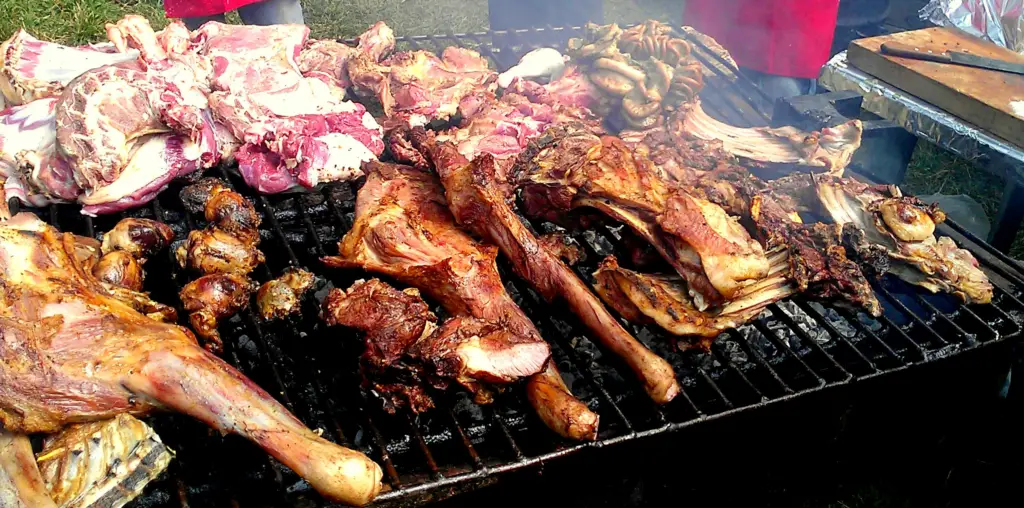
Nyama Choma, which translates to “grilled meat”, is a Tanzanian barbecue tradition. Historically, gatherings and celebrations were marked by slaughtering a goat or cow and roasting it.
In contemporary times, Nyama Choma has become an essential social activity, often enjoyed with a side of “ugali” and vegetables.
Tanzanian Cuisine – Ingredients for Nyama Choma
- Large meat chunks (goat/beef)
- Salt
- Chili (optional)
Tanzanian Recipes – Nyama Choma
- Season meat chunks with salt (and chili if desired).
- Skewer the meat and grill over charcoal until tender and smoky.
Presentation & Serving
Serve Nyama Choma straight from the grill with a side of kachumbari (tomato-onion salad) and ugali.
Drink Pairing
A cold local beer or a soft drink like Tangawizi (ginger soda) is an ideal companion for Nyama Choma.
Tanzanian Cuisine – Samaki wa kupaka

History and Background
“Samaki wa kupaka” directly translates to “fish with sauce.” It’s a popular Tanzanian dish, especially in the coastal regions, that showcases the unique blend of African, Arab, and Indian influences in Swahili cuisine. It is predominantly a coconut fish curry, characterized by its creamy texture and rich spices, largely attributed to the region’s historical involvement in the spice trade.
Tanzanian Cuisine – Samaki wa kupaka Ingredients
- 2 whole fish or fish fillets (preferably a white fish like tilapia or snapper), cleaned and scored
- 2 cups of coconut milk
- 2 tablespoons of vegetable oil or coconut oil
- 2 large tomatoes, finely chopped
- 1 large onion, finely chopped
- 4 garlic cloves, minced
- 1 tablespoon of ginger, minced
- 2-3 green chilies (adjust to taste)
- 1 teaspoon of turmeric powder
- 1 teaspoon of cumin seeds or powder
- 1 teaspoon of coriander powder
- 1 tablespoon of tamarind paste (or lemon juice as an alternative)
- Salt to taste
- Fresh cilantro (for garnishing)
- Lime or lemon wedges (for serving)
Tanzanian Recipes – Samaki wa kupaka
Marinate the Fish
- In a bowl, combine half the garlic, ginger, turmeric, salt, and a tablespoon of coconut milk. Mix to form a paste.
- Apply this mixture to the fish, ensuring it enters the scored parts. Let it marinate for at least 30 minutes.
Prepare the Sauce
- In a pot or deep pan, heat oil over medium heat. Add cumin seeds (if using cumin powder, add later).
- Once they splutter, add onions. Sauté until they’re translucent.
- Add the remaining garlic and ginger, sautéing until aromatic.
- Mix in the chopped tomatoes and green chilies. Cook until the tomatoes break down and become pulpy.
- Stir in turmeric, cumin powder (if not using seeds), coriander powder, and salt. Cook for another 2-3 minutes.
- Pour in the coconut milk and mix well. Simmer on low heat for about 10 minutes, stirring occasionally.
- Introduce the tamarind paste and adjust the salt if needed. Simmer for an additional 5 minutes.
Cook the Fish
- In a grill pan or skillet, heat some oil over medium heat. Place the marinated fish and sear each side until golden brown. This should take about 3-4 minutes per side for fillets.
- Once seared, transfer the fish into the pot with the sauce. Cover and simmer for 10-15 minutes, flipping the fish halfway to ensure even cooking.
Serve
- Once cooked, transfer the fish to a serving dish. Pour the sauce over the fish, garnish with fresh cilantro, and serve with lime or lemon wedges on the side.
Samaki wa kupaka pairs wonderfully with rice, especially coconut rice, or with flatbreads like chapati. Enjoy this Tanzanian delicacy with family and friends!
Tanzanian Cuisine – Pilau
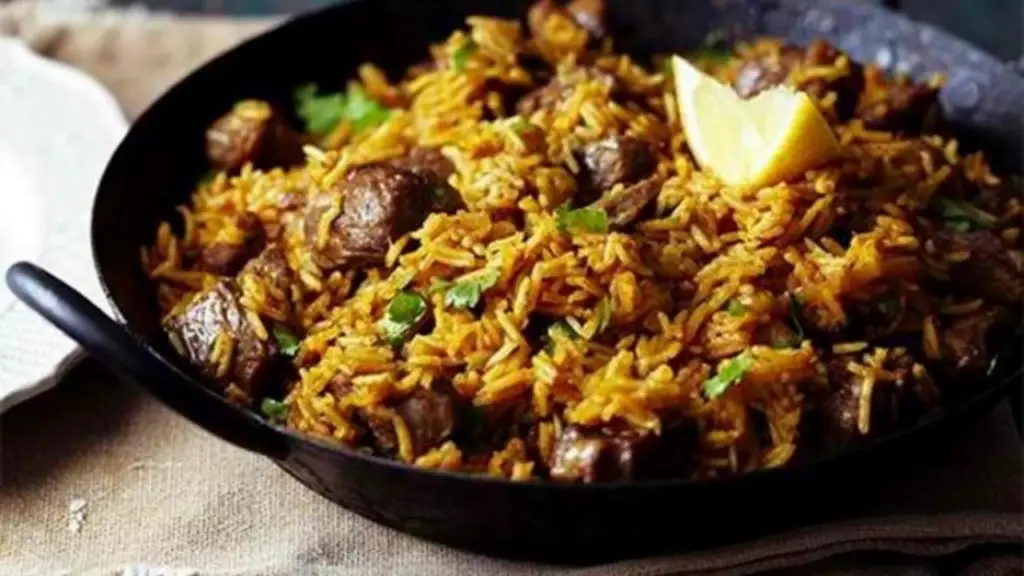
Pilau is a spiced rice dish that traces its roots back to the Indian subcontinent and the Middle East, introduced to the coastal regions of Tanzania by traders. It’s a celebratory dish that chefs often make during special occasions like weddings.
Tanzanian Cuisine – Pilau Ingredients
- 2 cups basmati rice
- 500g beef or chicken, cubed
- 1 onion, sliced
- 3 cloves garlic, minced
- 1 teaspoon ginger, minced
- 1 teaspoon cumin seeds
- 1 teaspoon cardamom powder
- 1 teaspoon clove powder
- Salt to taste
- 4 cups water or broth
Tanzanian Recipes
- In a pot, sauté onions until golden brown.
- Add garlic, ginger, and the meat cubes.
- Cook until meat is brown.
- Add cumin, cardamom, clove powder, and salt.
- Mix well.
- Add rice and stir for a few minutes.
- Pour in water or broth and bring to a boil.
- Lower the heat, cover, and let it simmer until rice is ready.
Serving Instructions
Serve hot with a side of kachumbari (Tanzanian salsa) and sliced bananas or fried plantains.
Tanzanian Cuisine – Mchemsho
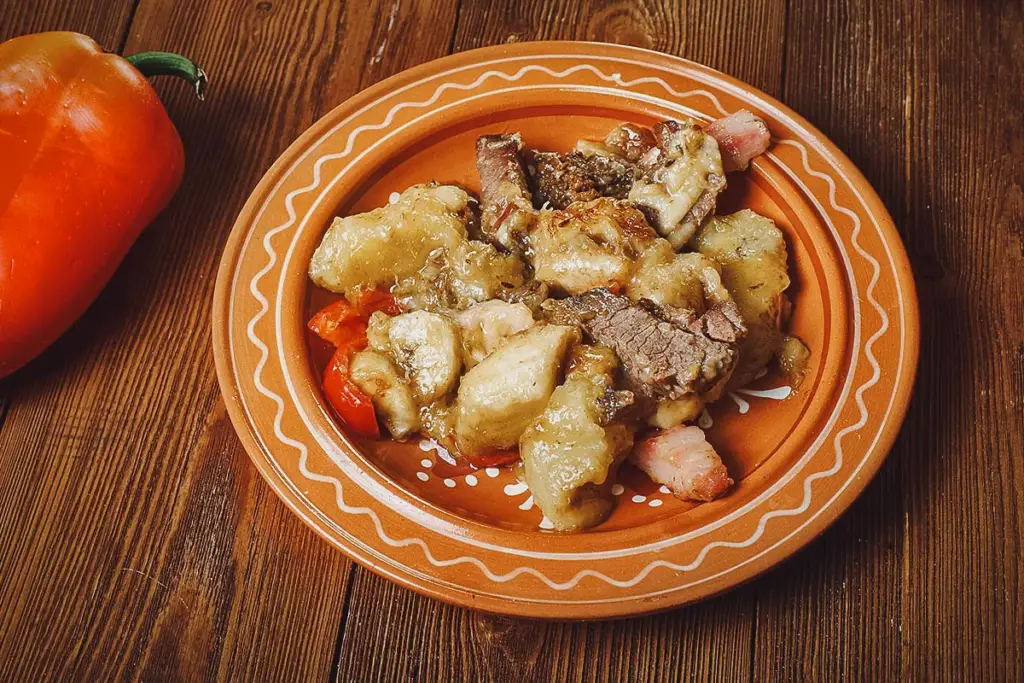
Mchemsho is a traditional Tanzanian stew that’s a blend of vegetables, meat, and sometimes even fish. Historically, this dish was an efficient way for families to use available ingredients. In contemporary Tanzania, it’s a symbol of unity, bringing together different flavors in one pot.
Tanzanian Cuisine – Mchemsho Ingredients
- 500g beef or chicken, cubed
- 2 tomatoes, chopped
- 2 carrots, sliced
- 1 onion, sliced
- 2 potatoes, cubed
- 1 bell pepper, chopped
- 1 eggplant, chopped
- Salt and pepper to taste
- 6 cups water
Tanzanian Recipes – Instructions
- In a large pot, combine all ingredients.
- Bring to a boil and then reduce to a simmer.
- Let it cook until meat and vegetables are tender, about 45 minutes to an hour.
Serving Instructions
Serve hot with a side of rice or ugali. Drizzle with fresh lime juice for an added zesty flavor.
Tanzanian Desserts – Vitumbua
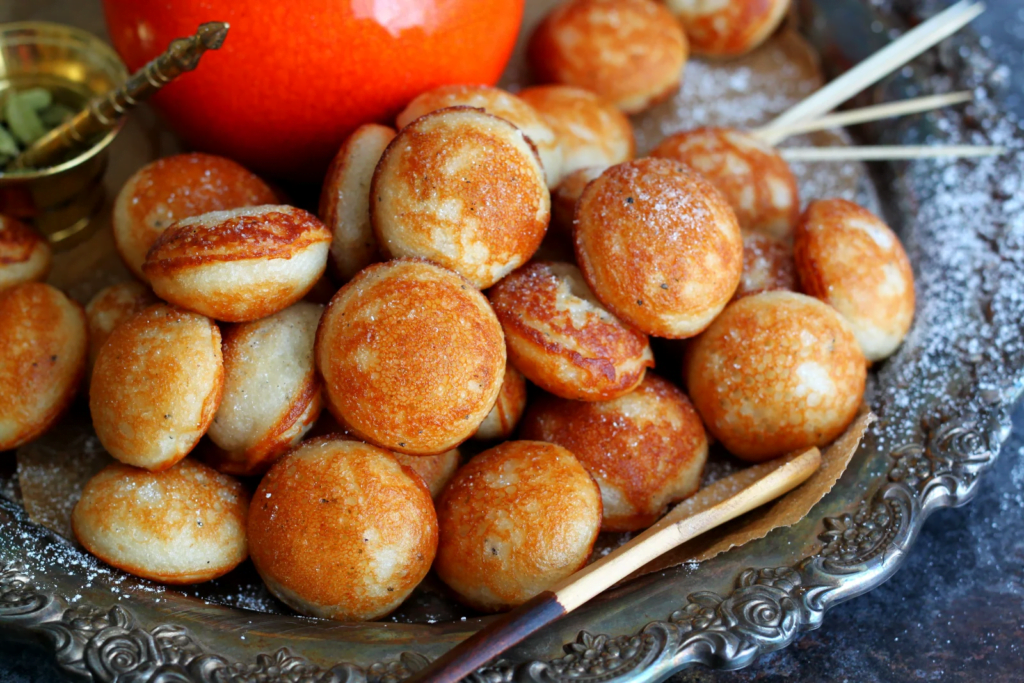
Vitumbua, often termed as rice pancakes or rice cakes, has its roots embedded in the coastal regions of Tanzania. Typically served during breakfast or as a tea-time snack, these little delights are a common sight during festive occasions and family gatherings.
Tanzanian Cuisine – Ingredients for Vitumbua
- 2 cups rice, soaked overnight
- 1 cup coconut milk
- 1/2 cup sugar
- 1/2 teaspoon yeast
- Pinch of salt
- 1/2 teaspoon cardamom powder
- Oil for frying
Tanzanian Recipes – Vitumbua
- Soak the rice overnight or for at least 6 hours.
- Drain the water and blend the rice with coconut milk to form a smooth batter.
- Add sugar, yeast, salt, and cardamom powder to this mixture and let it ferment for about 30 minutes.
- In a pan or Vitumbua skillet, pour a small amount of oil and once heated, pour the batter to form small pancakes.
- Cook until golden brown on both sides.
Presentation & Serving
Serve these golden-brown rice cakes stacked on a plate, either warm or at room temperature. A sprinkle of powdered sugar or a drizzle of honey can enhance the sweetness, though they are delicious on their own.
Perfect Drink Pair
A hot cup of Tanzanian chai (tea) with spices complements the subtle sweetness of Vitumbua.
Tanzanian Desserts – Mahamri
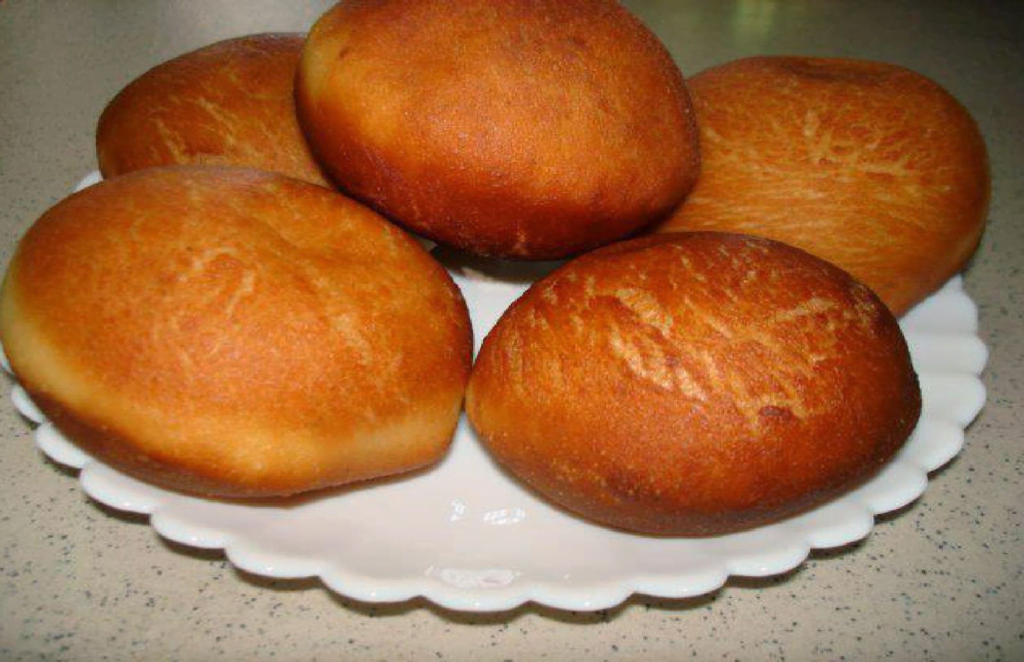
Mahamri, or coconut doughnuts, are a staple in the coastal regions, especially in Zanzibar. A common treat during the holy month of Ramadan, these are also savored during special occasions or simply enjoyed as a snack.
Tanzanian Cuisine – Ingredients for Mahamri
- 3 cups all-purpose flour
- 1 cup coconut milk
- 1/2 teaspoon active dry yeast
- 1/2 cup sugar
- 1/2 teaspoon cardamom powder
- Oil for frying
Tanzanian Recipes – How to prepare Mahamri
- In a mixing bowl, combine the flour, sugar, yeast, and cardamom powder.
- Slowly add coconut milk and knead the mixture into a soft dough.
- Cover the dough and allow it to rise for about 3 hours.
- Once risen, divide the dough into small balls and roll each into a semi-flat shape.
- Deep-fry in oil until they are golden and puffy.
Presentation & Serving
Powdered sugar. You can also pair them with a side of spicy kidney beans for a savory twist.
Perfect Drink Pair
A cold glass of tangawizi (ginger) drink or spiced tea is the perfect accompaniment to Mahamri.
Conclusion
Tanzanian cuisine is a celebration of flavors, traditions, and stories. Its puddings, in particular, capture the essence of the country’s rich heritage and the hearts of those who savor them. When you delve into Tanzanian dishes, you’re not just tasting food, but also partaking in a centuries-old legacy.
FAQ’s
How did Arabian influences enter Traditional Tanzanian Food?
Due to centuries of trade and interaction, Arabian flavors, techniques, and ingredients found their way into Tanzanian cuisine, enriching it.
What are common spices used in Tanzanian dishes?
Cardamom, cloves, cumin, and turmeric are some of the prevalent spices used to flavor Tanzanian meals.
How is Tanzanian chai different from other teas?
Tanzanian chai is often brewed with spices like ginger and cardamom, and sometimes milk, offering a distinctive, aromatic flavor.
What’s the significance of coconut in Tanzanian dishes?
The coastal regions of Tanzania are abundant with coconut trees, making coconut a staple ingredient in both savory dishes and desserts.
Is street food popular in Tanzania?
Absolutely! From grilled meats (mishkaki) to fried cassava chips, street food is an integral part of Tanzanian urban culture.
Describe Tanzanian Traditional Food
Tanzanian traditional food reflects the rich culinary heritage of the country. Staple dishes include ugali, a cornmeal porridge often served with Sukuma wiki (collard greens) or nyama choma (grilled meat).
Other popular options include pilau (spiced rice), samosas, and mchicha (a spinach-based dish). The diverse flavors and use of local ingredients make Tanzanian cuisine a delightful experience.

